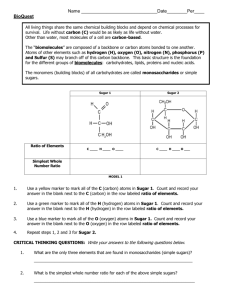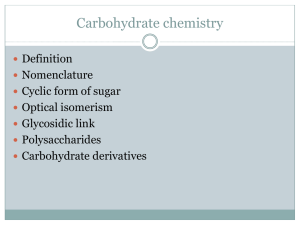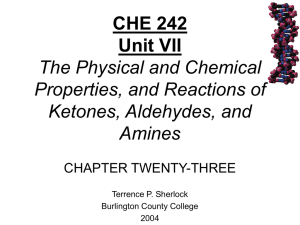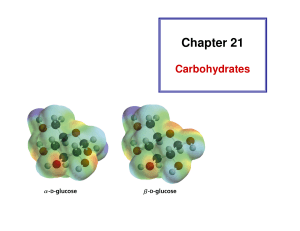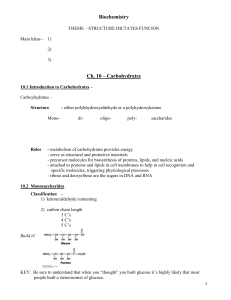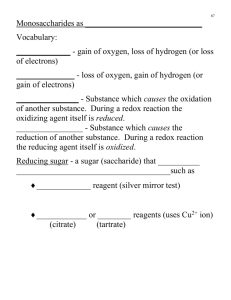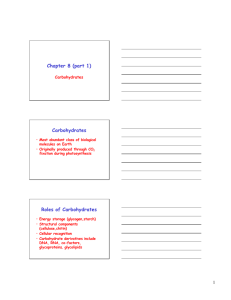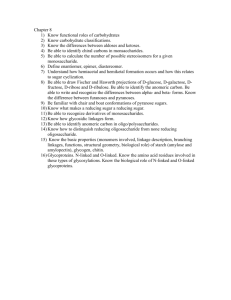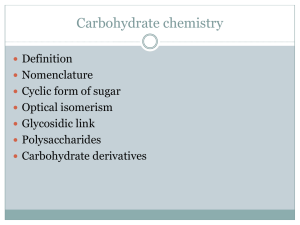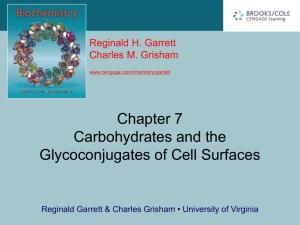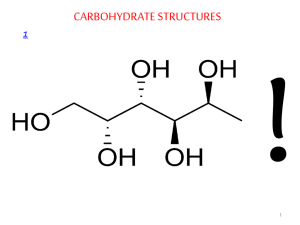survey of biochemistry - School of Chemistry and Biochemistry
advertisement
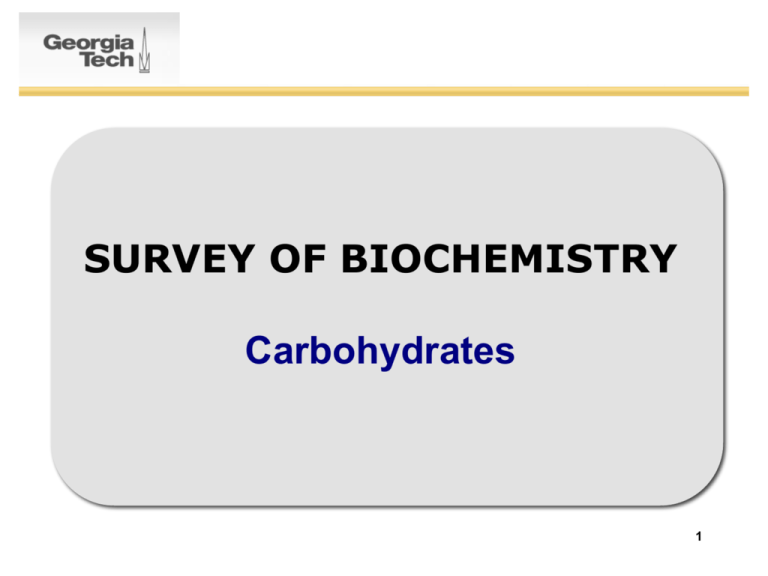
SURVEY OF BIOCHEMISTRY Carbohydrates 1 What are Carbohydrates? • Generic Formula of Simple Carbs (CH2O)n • Sugars formed from CO2 and H2O • Roles – Energy in diet – Mediating intercellular communication – Structural support (e.g. cell walls) 2 Classification • Monosaccharides – Aldoses – Ketoses • Polysaccharides (Glycans, Glycosides) • Glycoproteins: sugars bound to proteins – N-linked Oligosaccharides – O-Linked Oligosaccharides 3 Aldoses & Ketoses Sugars made from aldehydes form aldoses Sugars made from ketones form ketoses 4 Important Aldoses To Study 6-C sugars 5-C sugar All begin with CHO group 5 Important Aldoses To Study 6-C sugars 5-C sugar All end with group 6 Important Aldoses To Study 6-C sugars 5-C sugar Most names end with -ose suffix 7 Important Ketoses To Study 3-C sugar 5-C sugar 6-C sugar Most names all end with -ulose suffix 8 Important Ketoses To Study 3-C sugar Ketoses begin with 5-C sugar 6-C sugar group 9 Important Ketoses To Study 3-C sugar Most ketoses end with 5-C sugar 6-C sugar group 10 Important Ketoses To Study 3-C sugar 5-C sugar 6-C sugar Several ketoses end with -ulose suffix 11 Structures of Monosaccharides • Isomers and Epimers • Enantiomers • Anomeric Carbons • Ways to Draw Monosaccharides – Fischer Projection – Haworth Projection – Chair form Preferred 12 Isomers • Isomers are different compounds that have the same chemical formula C6H12O6 13 Epimers Epimers are sugars that differ only by the configuration around one carbon atom. Only difference 14 Enantiomers See Section 4-2 for help Know this structure Most sugars are found in the D-stereoisomer. D-Glyceraldehyde is the most simple aldose. 15 Cyclization of Monosaccharides Anomeric Carbons Anomeric Carbon 16 Cyclization of Monosaccharides Anomeric Carbons Anomeric Carbon Conformations Position of -OH Group on Anomeric C Down Up 17 Ways to Draw Monosaccharides • Fischer Projection - linear • Haworth Projection - cyclic • Chair - cyclic 18 Cyclization of Monosaccharides Up Down 19 Cyclization of Monosaccharides Up Down 20 Polysaccharides • Disaccharides: 2 sugars – Lactose: Glucose + Galactose – Sucrose: Glucose + Fructose – Maltose: Glucose + Glucose • Oligosaccharides: 3-12 sugars • Polysaccharides: 13+ sugars – Glycogen: homopolysaccharide of glucose – Glycosaminoglycans: heteropolysaccharides 21 Polysaccharides Monosaccharides can be linked to form oligosaccharides, and ultimately polysaccharides via glycosidic bonds. SUCROSE Glycosidic Bond 22 Polysaccharides Monosaccharides can be linked to form oligosaccharides, and ultimately polysaccharides via glycosidic bonds. LACTOSE Glycosidic Bond 23 Glycosidic Bonds in RNA 24 Starch in Plants 25 Starch in Plants 26 Glycoproteins: N-Linked 27 Glycoproteins: O-Linked 28 PRS • When comparing two enzymes, the optimal catalytic activity can be determined by_______. 1. 2. 3. 4. The The The The smallest Km largest KM smallest Vmax smallest kcat/KM 29 PRS • Which class of enzyme catalyzes group elimination to form double bonds? 1. 2. 3. 4. Transferases Isomerases Lyases Ligases 30 PRS • Which of the following proteins is involved in muscle contraction? 1. 2. 3. 4. Trypsin Troponin Chymotrypsin Hemoglobin 31 PRS • Which of the following is a ketose? 1. 2. 3. 4. Glucose Fructose Ribose Galactose 32
